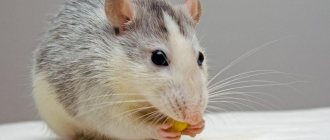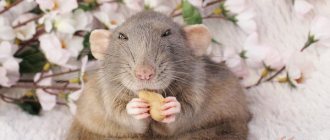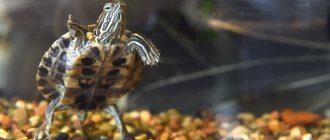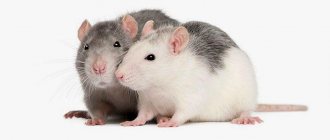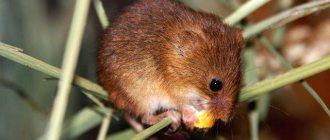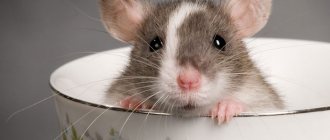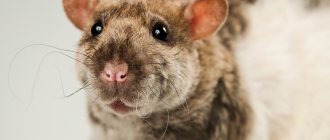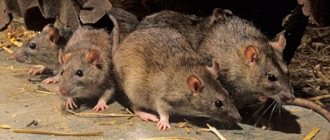The teeth of rats are strong, hard and sharp, with their help they can easily chew through wood, plastic, stone, concrete and even metal. To keep them healthy longer, you need to monitor the growth of the incisors, provide your pet with the necessary materials to grind them down, and if suspicious symptoms appear, consult a doctor.
It is also useful to know about the structural features of the rat’s dental system and the rules for caring for it.
How many teeth does a rat have
In total, both wild and decorative rats have 16 teeth - 4 large incisors and 12 molars (molars). Unlike other domestic animals, rodents do not have baby teeth. At the age of 7-8 days, the rudiments of molars appear in the pups, which remain with the animal for life.
To see all of a rat's teeth, you need to make it laugh. To do this, just tickle her tummy or under the neck. An amused rat will open its mouth wide in a kind of smile and squeak happily.
Mineral composition
A rat's teeth are made up of three layers:
- pulp;
- dentin;
- enamel.
Pulp is the soft core. This is a concentration of nerve canals and blood vessels. The pulp is surrounded by a harder layer of dentin. Its thickness exceeds the layers of pulp and enamel combined.
The outer coating – enamel – is the hardest and most durable. The enamel crown contains mineral components, the main one being calcium.
Structure of teeth
The anatomical features of the dentition of rodents are directly related to their diet and lifestyle. Distinctive features of the structure of the teeth of decorative rats are:
- growth of the front incisors throughout life by 3-4 mm per week - necessary to compensate for the size of the teeth after grinding;
- covering only the front part of the incisors with enamel, the back wall consists of soft dentin - thanks to this structure, the teeth are easily ground down when eating hard foods;
- the presence of a free gap between the incisors and molars - diastema;
- The rat chews solid food with its incisors, and grinds it with its molars before swallowing.
If a rat stops grinding its incisors, they will grow indefinitely, turning outward at an angle of 80ᵒ. This leads first to difficulties with eating, then to the death of the animal. The optimal length of the incisors is about 1 cm.
Small pouches of skin hang down between the incisors and molars of rats. They prevent small inedible fragments from entering the mouth when chewing food (for example, nut shells).
It is worth noting that molars have very hard enamel, so rodents usually do not have problems with them. Molars practically do not wear out and serve the animal faithfully throughout its life.
Rodent dental care
Under natural conditions, pasyuki take care of their teeth on their own. However, decorative rats do not have this opportunity. The owner should help them maintain healthy teeth.
What to give a rat to wear down its teeth
A healthy rat is able to independently grind its incisors on hard objects and food. All that is required from the owner is to organize the constant presence of such items in the cage. Ideal for grinding down rat teeth:
- Mineral stone . Pet stores sell regular and suspended ones. Just before buying, you need to carefully read the composition - there should be no salt in it. As a last resort, you can put regular hard chalk in the cage.
- Small tree branches . You can bring it from your site, or you can buy it. Rodents will most like apple, willow, walnut, and pear. It is worth noting that rats prefer fresh twigs; they lose interest in dry ones.
- Solid treats . For example, grass pads, edible houses for rodents, puffed grains, nuts. For more details, see the article “What treats can you give to rats.”
Experienced rat breeders also recommend placing small wooden blocks or cardboard boxes in the rat cage. Pets will quickly chew them off, grinding down their incisors.
How to trim a rat's teeth
In some situations, decorative rats categorically refuse the treat offered by the owner to grind down their teeth. Then there is nothing left but to trim the pet’s incisors. This should be done as it grows, when the teeth begin to interfere with the fluffy. On average, the interval between prunings is 5 days. The procedure is carried out as follows:
- The rat must be securely restrained so that it does not escape or twist its head. When pruning, there are two people – one holds, the other trims. When trimming yourself, you can swaddle the rat tightly (but not too tightly).
- To avoid sudden closure of the mouth, you will need to insert a regular pencil or an insulin syringe (without a needle) into the diastema.
- It’s not worth cutting your hair right away. At first the rat will struggle and squeak. You need to wait until the animal calms down.
- When the right moment comes, you will need to install nail clippers along the incisors and trim with one click.
- Immediately tilt the animal's head down. This is necessary so that the incisors do not get into the pet’s throat. To be sure, it is recommended to immediately find and throw in the trash the fragments of cut incisors.
The cut should be smooth. There is no need to sharpen the teeth - the rat will sharpen them on its own in the process of gnawing solid food and improvised means. The main thing is not to be afraid or nervous, because the owner’s excitement is transferred to the animal. Rats completely lack nerve endings in their teeth, so the pet will not experience any discomfort (except for mild stress).
If you are unsure and afraid to trim at home, it is better to consult a veterinarian for the first time. The specialist will carry out the procedure in a matter of minutes, and will also give the owner detailed recommendations regarding trimming the pet’s incisors on their own.
Features of incisor growth
Their function is to grasp (almost like paws), bite and gnawing, and peel seeds. As mentioned above, they are constantly growing. The top two are slightly longer than the bottom two.
They appear in rat pups 10 days after birth and develop quite quickly. They reach their full length at 40–50 days. Their average growth force is 2.2 mm (upper) and 2.8 mm (lower) per day. However, different conditions can affect incisor growth in different ways. Pruning can slow down their development by half, but gnawing on hard substances contributes to intense wear and, as a result, greater intensity of their growth.
Did you know? Rats are very intelligent creatures and can be trained just as well as dogs or cats.
The sharpness of the incisors is constantly maintained by grinding.
The rat constantly makes movements, as if knocking its incisors, erasing them. They are covered with enamel on the outside, but on the inside it seems to disappear. This softer inner layer is sharpened by these angled movements to create a cutting surface. The enamel of the incisors is 5.5 Mohs hardness units, equal to steel.
The animal's jaws are movable, which makes it possible for the lower incisors to diverge up to 40° when biting, gnawing or chewing.
During gnawing, the upper part of the rat's jaw moves forward, holding food with the upper incisors, and the lower incisors cut it, while the molars are not involved and are not subject to wear.
Behind the incisors on the back of the cheeks of decorative rats there are folds that protrude into the space between the incisors and molars. With their help, harmful particles do not enter the rodents' body.
Did you know? Rats are ticklish and laugh when tickled.
How to trim incisors
To maintain the healthy state of the oral cavity of a decorative pet rat, you need to perform simple procedures: constantly provide it with the necessary toys or materials for grinding, and also, in case of outgrowth (when they begin to interfere with its normal feeding and the animal begins to walk with its mouth open), you can painlessly shorten them by a few millimeters. This is a quick and safe procedure, since there are no nerve endings in the enamel, but it must be performed by a veterinarian.
If the rodent is deprived of the opportunity to grind down the incisors on its own, then the shortening procedure should be carried out once every 10–14 days.
Sometimes it can be difficult to find a specialist who is willing to tinker with trimming your pet's teeth. In this case, you can do the pruning yourself. To do this you need to have good quality nail clippers. The rat must be held upside down to avoid splinters getting into the throat. Press on the base of the jaw from both sides or open the jaw with a stick and cut off the incisor in one movement perpendicular to the tooth.
Find out also about the life expectancy, maintenance and nutrition of decorative rats.
Why do rats have yellow or orange teeth?
The baby rats are getting absolutely white, beautiful teeth. But already at the age of 3 weeks they begin to gradually turn yellow. By 5 weeks, the upper incisors already acquire an orange tint, and the lower ones - a rich yellow.
Many owners of decorative rodents, noticing these metamorphoses, begin to sound the alarm and take the animal to veterinary clinics. Most often, caring owners believe that their pet’s teeth darken due to caries or tartar. However, such fears are in vain. On the contrary, the brighter the rat’s teeth are colored, the better. After all, a rich color appears as the enamel layer strengthens and thickens.
With age, rodents' incisors darken, and this is normal. On the contrary, if an elderly rat’s teeth are white, even with a slightly yellowish tint, this is a reason to think about it. Most likely, your pet's incisors are not strong enough. In any case, you will have to contact a veterinarian.
Frequent dental problems
The most common dental problem in rats is, as is known, the constant growth of the incisors, especially if the pet refuses to independently work on grinding them down. Sometimes overgrown teeth grow into the gums or into the skin around the mouth, causing severe pain to the animal. However, rodents also have other dental problems:
- Malocclusion - the animal simply cannot close its mouth normally. In such situations, the pet cannot fully grind down its teeth, so it will have to learn how to trim on its own.
- Abscess - in the presence of small wounds in the oral cavity, suppuration may develop. In advanced cases, it is necessary to remove the tooth along with the abscess.
- A tooth fracture usually indicates an injury to your pet. A rat can break a tooth, for example, when falling from a height or chewing on very hard objects.
- Dental diseases . Decorative rats, like humans, often suffer from oral diseases. For example, caries, stomatitis, periodontitis and many others.
If one of the listed problems occurs, you should contact a ratologist as soon as possible. Perhaps the animal can be helped to completely preserve its dentition.
Causes
The causes of dental diseases can be hereditary, related to the structural features of the bones of the skull and teeth, or acquired.
Acquired ones include, first of all, improper feeding. In nature, rodents and lagomorphs feed on tough grasses, leaves and bark, which ensure uniform grinding of teeth. At home, owners often offer their pet what they think it likes best - juicy and soft food. An imbalance between rough and soft foods often leads to the formation of malocclusion and malocclusion, when teeth stop wearing properly.
Other causes of dental diseases include disturbances in calcium-phosphorus metabolism, trauma to the teeth and jaw, abscesses and tumors. In addition, malocclusion can occur as a result of refusal to eat in the presence of other diseases. Rodents and lagomorphs very often refuse food completely or partially if they experience pain or discomfort. Sometimes a few days of not eating is enough for the bite to become disrupted.
Disease Prevention
Dental problems in rats can significantly reduce the quality of life of furbabies. With sick teeth, they will not be able to eat normally or grind their incisors on their own. Therefore, the owner of a rodent must always maintain his pet’s smile in perfect condition. To do this you need:
- introduce solid food into the rat’s diet - grains, nuts in shells, boiled chicken bones, fresh carrots, green apples;
- ensure that special accessories for grinding incisors are always in the cage;
- if necessary, constantly trim the rat’s front teeth;
- Constantly change the water in the drinking bowl, and do not draw liquid from the tap - this can lead to the deposition of tartar.
Also, if you suspect that a rat has dental diseases, your pet should be immediately shown to a specialist. The reason for contacting a veterinarian is the appearance of one or more alarming symptoms:
- the appearance of scratches and abrasions in the oral cavity;
- extraneous sounds (tapping, clicking or grinding) while eating;
- increased salivation;
- swelling of the tongue or gums;
- tooth loss or fracture;
- lightening or blackening of enamel;
- the appearance of tumors in the jaw area;
- strong unpleasant odor from the mouth.
The veterinarian will examine the furry cat and give detailed recommendations for the treatment and prevention of dental diseases. In some situations, rats have to have their teeth removed. But you shouldn’t worry too much about this - even in the absence of incisors, the pet will be able to cope with chewing food with the help of molars. The main thing is to cure the fluffy and stop the progression of the disease.
The characteristics and structure of a rat’s teeth can tell a lot. Therefore, a loving owner must clearly know how many teeth a pet should have and what they should look like in a healthy animal. And then the fluffy can be calm - the owner will take care of his smile and well-being.
What happens if you don’t seek help in a timely manner?
Sometimes owners hope that dental problems can resolve themselves. Unfortunately this is not possible. Changes occur in the oral cavity that cannot disappear on their own.
The incisors become excessively long and grow incorrectly. The animal is unable to grasp and bite food, which leads to starvation.
The lower cheek teeth begin to grow towards the tongue, and ulcers appear on the tongue from a tooth injury. Over time, the lower teeth completely close over the tongue with a “bridge”, and, as a result, the animal cannot chew, push and swallow food.
Upper molars and premolars tend to grow toward the cheeks. In this case, the sharp hooks injure the cheek and it is painful for the animal to chew. In the places where the hooks dig in, non-healing wounds appear, into which food gets trapped. This can cause abscesses to form.
Significant lengthening of the chewing teeth can lead to dislocation of the jaw, in which case the animal will never be able to eat solid food, and bite correction will be required very often.
